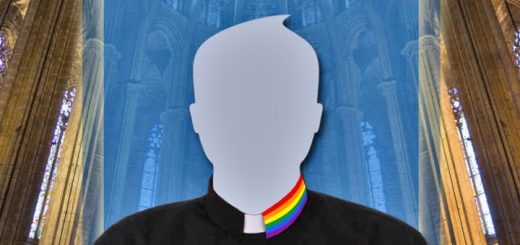The Catholic Church and the gays. The original, sober and changing lives of the homosexual clergy through the centuries
Article by Andrew Sullivan published on the fortnightly website New York (United States) on January 21, 2019, fourth part, freely translated by Giacomo Tessaro
The great proportion of gays in the clergy is actually nothing new in the Catholic Church. For over a millennium it was a normal thing, and even if in the past it was occasionally reported, usually the popes did not take any provision.
For example, as the historical deceased has shown John Boswell in its fundamental book Christianity, tolerance, homosexuality. The Church and homosexuals from the origins to the 14th century (Leonardo, 1989), Giovanni Crisostomo, [Father of the Church] of the 4th century, attacked the leaders of the Church to be too tolerant of homosexual relations: "The people themselves who have nourished by the divine doctrine, who instruct others by saying what they should or do not have to do [...] that they do not accompany themselves with the prostitutes as brazenly how they do with young people [...] Nobody is ashamed, nobody blushes [...] Those who are Casti seem the exception, and those who disapprove seem to be in foul".
The Christians, following the teachings of Saint Paul and Sant'Agostino, feared sex in general, but not everyone agreed on the fact that homosexuality, if it was limited to an intense mutual love and caste friendship, was problematic.
Even Sant'Agostino had a particularly intense love story with a young man: "I felt that my soul and his had been 'a single soul in two bodies'; therefore life made me horror, since I did not want to live by means, and therefore perhaps I was afraid of dying, so as not to let those who had much loved completely die" [Confessions, book IV]. It was not a simple spiritual friendship, confesses Agostino: "I thus polluted the source of friendship with the lies of the concupiscence and obscured the candor with the darkness of libido".
Some hypothesized that the Manichea doctrine of Agostino, who drastically opposed the spirit and body, is at the root of his disgust towards his homosexual tendencies; However, historical testimonies reveal that, beyond the influence of Augustine, the intense homoerotic friendships between members of the clergy were very common in the following centuries, especially in monasteries. (As well as in female convents. The gifts that lesbians have gone to the Church are equally extraordinary, but since the priesthood is exclusively male and women cannot access authentic positions of power, the lesbian nuns, for better or for worse, are not involved in the current crisis.)
The masterpiece of"Spiritual friendship" It was written by a homosexual, Sant'Aelredo, abbot of the Cistercian monastery of Rievaulx in England around 1160. In the youth years he had had sexual relations with men, but when he became a monk and voted for chastity sublimated those desires in an idea of intense love chaste for another man, taking as a model the relationship between Jesus and "The disciple that Jesus loved", Giovanni, describing it at a certain point even as a "marriage".
Aelredo considered the intimacy of Jesus with John (for example in the last dinner, when John supports his head on Jesus' chest) as a model of relationship with another man "With which you can be united in the intimate embrace of the most sacred love [...] with which you can rest, only with him, in the sleep of peace, far from the noise of the world, in the embrace of love, in the kiss of the unity".
In the twelfth century The priests and monks wrote love letters to their confreres in what Boswell defines "A flowering of Christian gay literature still without parallels in the western world". Perhaps in response to this wide acceptance of gay spirituality, others undertook an offensive.
Around 1051 San Pier Damiani he published a treaty, the Liber Gomorrhianus (Book of Gomorrah), whose rhetoric is surprisingly similar to complaints online of our era: "In the most absolute way no other vice can be reasonably compared to this [...] In fact it is the death of the body, the destruction of the soul [...] completely removes the truth from the mind".
San Pier Damiani accused the Church of being guided by a gay camarilla, in which [the homosexual priests] covered and granted each other the acquittal for their sins.
Pope Leone IX however refused to sanction them and claimed that the problem was sex "When it has been practiced for a long time or with many men"; An occasional fall, if confessed, could be forgiven. Leone IX was in agreement with Francesco.
San Pier Damiani was the greatest reformer of the Church of his time, and his work was very far beyond this question; In 1059 a Synod gave an answer to all its numerous proposals, except for that on gay priests. Pope Alexander II came to the point of asking him the only manuscript of his Liber Gomorrhianus To be able to copy it, instead he laid it under key!
When the saint asked him right, the Pope "He laughed and tried to subside me with the oily humor of good education".
In 1102 the Council of London, animated by similar concerns, decided to promulgate a decree against the sin of "sodomy" (a new definition), but the archbishop of Canterbury blocked his publication, with the justification that "This sin has been so widespread so far that someone is hardly embarrassed".
The wind decidedly turned in the thirteenth century, when the theological genius of St. Thomas Aquinas condemned the homosexual acts such as "Against nature". Sex is reserved for married couples open to procreation, and any other sexual activity constitutes a serious sin.
In this new theology homosexuals they are partof creation (the homosexual behavior of some animals had already been noticed, especially hares and hyenas), but somehow they are also opposedto creation. Thomas never resolved this paradox, nor did the Church ever done so.
In the following centuries, homosexuality became more and more a taboo, but there is no reason to believe that gay priests disappeared: they only hidden better, and homosexual love was deeply rooted in Catholic Christianity. The friendship between Sant'Ignazio of Loyola and St. Francis Saverio, for example, gave birth to the Society of Jesus (Jesuits) in the 16th century. Ignazio gave Francesco the task of evangelizing Asia and their long separation was a source of suffering for both. Here is the response of Francesco (Saverio) to a letter from Ignazio: "Among the many other and holy words and consolations of his letter, I read the latest they said:" All yours, without ever being able to forget you, Ignatius ", who, as with tears I have read them, with tears I write them [...] Your Holy Charity writes to me what desire she has to see me before ending this life. Our Lord knows how much emotion they made these words of such great love in my soul". I never see again.
The greatest Catholic theologian of the 19th century, the cardinal John Henry NewmanIn private he was very devoted to another man, Ambrose St. John. This does not mean that the two had a sexual relationship (even if it is possible), but suggests the fact that the deep homosexual love was still practiced to the highest degrees of the Catholic clergy, even at the height of the Victorian repression and even aside a man considered by many to be a saint.
When Ambrose St. John died, Newman wrote "I had always thought that no mourning was comparable to that of a husband or a wife, but now I think it is difficult to believe that a mourning or pain can be bigger than mine".
It is known that Newman converted to Catholicism from Anglicanism and that he had been part [before conversion] of the Oxford movement [an Anglican reformist movement that hoped for a decisive rapprochement on Catholicism, ndt], strongly influenced by homosexual people. Newman insisted on being buried ("Like my last imperative will") in the same tomb as Ambrose St. John. On the plaque, the words that the two had dictated: "From the shade and from symbols to truth".
The greatest Catholic poet of the nineteenth century, the Jesuit Gerard Manley Hopkins, was gay, as was one of the deepest priests-theologians of the twentieth century, Henri Nouwen. Both were subject to attacks of profound depression. There is no proof that broke the chastity and celibacy, but they fell in love, have fought with solitude and produced works of immense beauty and spirituality.
The most beautiful work of Nouwen is a reflection on the parable of the prodigal son; one of Hopkins' most famous poems, Varied beauty, is a peana dedicated to "All contrasting things, original, sober, strange; / all that is changing and - who knows how - spotted [...] generates the one without respite, whose beauty is immutable. / Praise to him".






